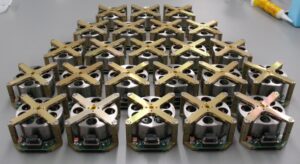Rocket Lab USA Inc. has released two products aimed at the small-satellite market.
The Long Beach company debuted earlier this month a software-defined radio, plus a reaction wheel used for attitude control in spacecraft.
The products join Rocket Lab’s heritage space systems components including star trackers, reaction wheels, separation systems, radios, flight software, ground software, and solar power products.
Combined, Rocket Lab’s space systems components have supported more than 1,700 missions to date, according to a release from the company.
The Frontier-X radio is designed to provide high-speed data for both near-Earth and deep-space satellite missions, the release from Rocket Lab said.
Frontier-X is available for order now; production is taking place at Rocket Lab’s headquarters in Long Beach, the release added.
The Rocket Lab radio is based on the Johns Hopkins University Applied Physics Laboratory’s Frontier Radio. The company had launched the Frontier-S version of the radio on its Photon spacecraft, a Rocket Lab designed and launched spacecraft that deployed the Capstone satellite for NASA.
Capstone was launched by Rocket Lab on an Electron rocket from New Zealand last June.
The Frontier-X radio is a high-speed transceiver designed to expand the reach of small satellites beyond low-Earth orbit to cislunar and deep-space destinations as well as provide an affordable alternative for mission payload downlink, the company’s release said.

The Rocket Lab Frontier-X radio joins the Frontier-S ranging RF transceiver in bringing advanced functionality not typically available in affordable software-defined radios.
This includes a coherent transponder to enable radiometric navigation methods, precision timekeeping functions, turbo and convolutional encoding compliant with recommended standards by the Consultative Committee for Space Data Systems, and a hardware-based critical command decoder, the release said.
The X-band radio packs Deep Space Network waveforms, two-way doppler and two-way ranging for navigation beyond low-Earth orbit, beacon modes and low baud rates enabled by low-power digital signal processing in a low-mass solution.
The Fronter-X radio has the durability to survive in high radiation environments beyond Earth orbit, including to geostationary orbit and deep space, the release added.
While the standard configuration for a low-earth orbit radio costs $175,000, the standard configuration of a deep space radio has a price tag of $225,000.
The new 12Nms reaction wheel has been developed to expand attitude control solutions and comes in standard and a more radiation-hardened variants.The wheel, designed for long life and reliability, is ideal for attitude control of spacecraft with masses as high as 600-650 kg and lifetimes as long as 12 years, the Rocket Lab release said.
Rocket Lab’s reaction wheels have been used in more than 100 satellites to date for missions and constellations focused on remote sensing, communications, science, technology demonstrations and more.
The cost of the wheels is $100,000 for the standard, low-earth orbit version and $120,000 for the radiation-hardened version.
The company also announced that it had appointed Colin Canfield to lead its investor relations division.
“We’re delighted to have Colin on the team. He brings with him deep knowledge of the space industry and a wealth of experience working with the investment community,” said Rocket Lab Chief Financial Officer Adam Spice.
